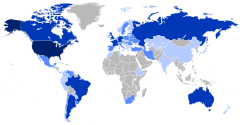
Back Joodse diaspora Afrikaans Jüdische Diaspora ALS الشتات اليهودي Arabic شتات اليهود ARZ قالوت AZB Еврейска диаспора Bulgarian Diàspora jueva Catalan Židovská diaspora Czech Y diaspora Iddewig Welsh Den jødiske diaspora Danish
| Part of a series on |
| Jews and Judaism |
|---|


The Jewish diaspora (Hebrew: גוֹלָה, romanized: gōlā), dispersion (Hebrew: תְּפוּצָה, romanized: təfūṣā) or exile (Hebrew: גָּלוּת gālūṯ; Yiddish: golus)[a] is the dispersion of Israelites or Jews out of their ancient ancestral homeland (the Land of Israel) and their subsequent settlement in other parts of the globe.[3][4]
In terms of the Hebrew Bible, the term "Exile" denotes the fate of the Israelites who were taken into exile from the Kingdom of Israel during the 8th century BCE, and the Judahites from the Kingdom of Judah who were taken into exile during the 6th century BCE. While in exile, the Judahites became known as "Jews" (יְהוּדִים, or Yehudim).[5][6]
The first exile was the Assyrian exile, the expulsion from the Kingdom of Israel begun by Tiglath-Pileser III of Assyria in 733 BCE. This process was completed by Sargon II with the destruction of the kingdom in 722 BCE, concluding a three-year siege of Samaria begun by Shalmaneser V. The next experience of exile was the Babylonian captivity, in which portions of the population of the Kingdom of Judah were deported in 597 BCE and again in 586 BCE by the Neo-Babylonian Empire under the rule of Nebuchadnezzar II.
A Jewish diaspora existed for several centuries before the fall of the Second Temple in 70 CE. The Jewish diaspora in the second Temple period (516 BCE – 70 CE) was created from various factors, including through the creation of political and war refugees, enslavement, deportation, overpopulation, indebtedness, military employment, and opportunities in business, commerce, and agriculture.[7] Before the middle of the first century CE, in addition to Judea, Syria and Babylonia, large Jewish communities existed in the Roman provinces of Egypt, Crete and Cyrenaica, and in Rome itself.[8] In 6 CE the region was organized as the Roman province of Judaea. The Judean population revolted against the Roman Empire in 66 CE in the First Jewish–Roman War, which culminated in the destruction of Jerusalem in 70 CE. During the siege, the Romans destroyed the Second Temple and most of Jerusalem. This watershed moment, the elimination of the symbolic centre of Judaism and Jewish identity motivated many Jews to formulate a new self-definition and adjust their existence to the prospect of an indefinite period of displacement.[9]
In 132 CE, Bar Kokhba led a rebellion against Hadrian, a revolt connected with the renaming of Jerusalem as Aelia Capitolina. After four years of devastating warfare, the uprising was suppressed, and Jews were forbidden access to Jerusalem.
During the Middle Ages, due to increasing migration and resettlement, Jews divided into distinct regional groups that today are generally addressed according to two primary geographical groupings: the Ashkenazi of Northern and Eastern Europe, and the Sephardic Jews of Iberia (Spain and Portugal), North Africa and the Middle East. These groups have parallel histories sharing many cultural similarities as well as a series of massacres, persecutions and expulsions, such as the expulsion from England in 1290, the expulsion from Spain in 1492, and the expulsion from Arab countries in 1948–1973. Although the two branches comprise many unique ethno-cultural practices and have links to their local host populations (such as Central Europeans for the Ashkenazim and Hispanics and Arabs for the Sephardim), their shared religion and ancestry, as well as their continuous communication and population transfers, has been responsible for a unified sense of cultural and religious Jewish identity between Sephardim and Ashkenazim from the late Roman period to the present.
- ^ "golus". Jewish English Lexicon.
- ^ "galuth". Merriam-Webster.com Dictionary. Merriam-Webster.: “Etymology: Hebrew gālūth”
- ^ "Diaspora | Judaism". Encyclopedia Britannica. Retrieved 2018-07-12.
- ^ Ben-Sasson, Haim Hillel. "Galut." Encyclopaedia Judaica, edited by Michael Berenbaum and Fred Skolnik, 2nd ed., vol. 7, Macmillan Reference (US) 2007, pp. 352–63. Gale Virtual Reference Library
- ^ "Jew | History, Beliefs, & Facts | Britannica". www.britannica.com. 2024-07-03. Retrieved 2024-07-06.
- ^ Chouraqui, André (1975). The people and the faith of the Bible. Internet Archive. Amherst : University of Massachusetts Press. p. 43. ISBN 978-0-87023-172-8.
- ^ Erich S. Gruen, Diaspora: Jews Amidst Greeks and Romans Harvard University Press, 2009 pp. 3–4, 233–34: "The vast bulk of Jews who dwelled abroad in the Second Temple period did so voluntarily. Even where initial deportation came under duress, the relocated families remained in their new residences for generations—long after the issue of forced dislocation had become obsolete. No single objective impelled them; there were multiple motives. Overpopulation in Palestine may have been a factor for some, indebtedness for others. But hardship need not have been the spur for most. The new and expanded communities that sprang up in the wake of Alexander’s conquests served as magnets for migration. And Jews made their way to locations in both the eastern and western Mediterranean. Large numbers found employment as mercenaries, military colonists, or enlisted men in the regular forces. Others seized opportunities in business, commerce, or agriculture. All lands were open to them."
- ^ E. Mary Smallwood (1984). "The Diaspora in the Roman period before CE 70". In William David Davies; Louis Finkelstein; William Horbury (eds.). The Cambridge History of Judaism: The early Roman period, Volume 3. Cambridge University Press. ISBN 978-0521243773.
- ^ Gruen, Diaspora: Jews Amidst Greeks and Romans, Harvard University Press, 2009 pp. 233–34:
Cite error: There are <ref group=lower-alpha> tags or {{efn}} templates on this page, but the references will not show without a {{reflist|group=lower-alpha}} template or {{notelist}} template (see the help page).